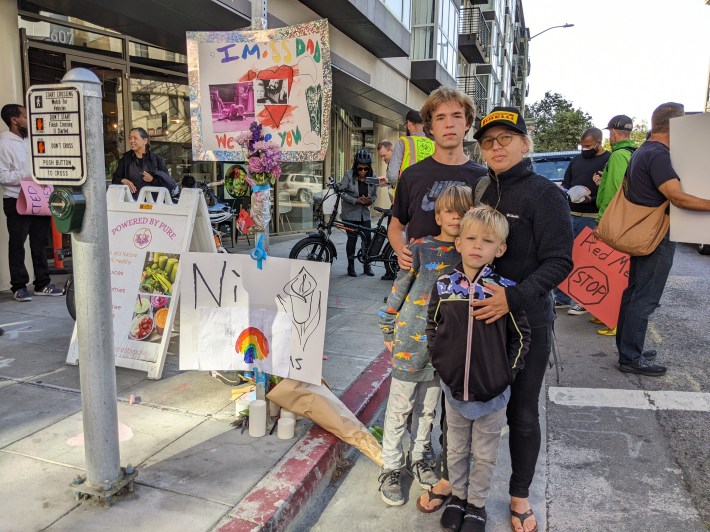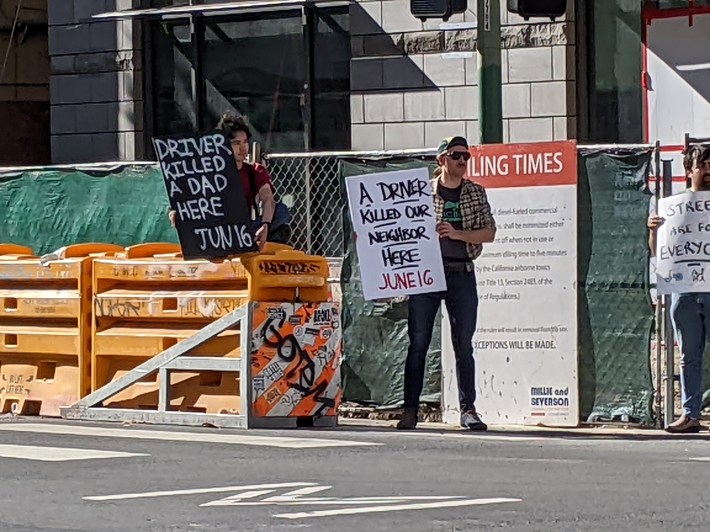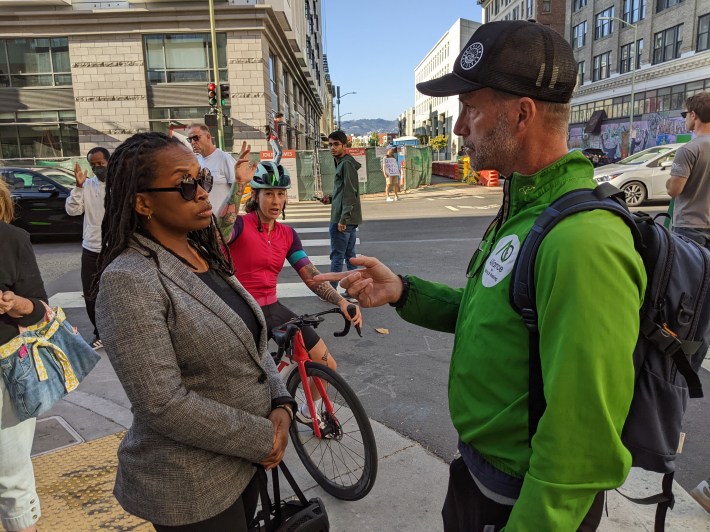Note from the editor: To the family of Dmitry Putilov, I tried my best to hear your stories and get the spellings of your names. I'm afraid, given the translation from Cyrillic to sign language to English, I may have gotten a few spellings wrong. If so, I apologize in advance.
Oakland lawmakers will decide Tuesday whether to approve an important safe-street redesign for 14th Street in downtown Oakland. Streetsblog will update this post to reflect the result; however, given what happened Thursday evening, it seems imponderable that anyone on the council would vote against the plan for protected bike lanes.
[Update, Tues. 3:24 p.m.: Oakland City Council approves 14th Street unanimously]
From the CBS local affiliate's story on the death of Dmitry Putilov:
A 42-year-old man was struck and killed by a hit-and-run driver as he was riding his bicycle in downtown Oakland Thursday night. Shortly before 8:30 p.m., the Oakland man was riding his bike on Jefferson Street near 14th Street when he was hit by
a vehicle[the motorist] that was traveling in the same direction, according to Oakland police. The cyclist was riding in a designated bike lane at the time, police said. He was taken to a hospital where he was pronounced dead.
Putilov's two smaller children were riding with him and witnessed this atrocity. Streetsblog met them and their mother during a demonstration and vigil held Saturday at the site.
"My family has always loved cycling," said Alena Putilov, the victim's ex-wife and mother of his children. "It's so horrific that the driver didn't stop."

The children made chalk drawings on the sidewalk, seemingly unable to fully process what they'd experienced. However, the thirty-some advocates who attended were highly aware of this latest horror and how easily it could have been prevented. As Bike East Bay advocate Robert Prinz Tweeted below:
A father was killed in front of their children, by a hit-run driver on a corridor that was awarded $10.5M for safety upgrades in 2016, but not yet built. I am furious. I have no other words.https://t.co/rxhhosyjFN
— Robert Prinz (@prinzrob) June 17, 2022
Of course, the primary responsibility is with the driver. But advocates and anyone else who studies street design know that, despite the motorist's egregious behavior, sufficiently robust infrastructure could have saved the man's life.
"We have car safety infrastructure, but not human safety infrastructure," said advocate Bryan Culbertson.
He was referring, in part, to the inexpensive, temporary barriers protecting the construction site on the northwest corner of the intersection (see image below), within sight of where Putilov was killed. These ubiquitous, bright orange plastic barriers are generally filled with water, sand, or gravel and can stop a motorist from plowing into construction workers and materials. This one includes a "sled," an energy absorption device that will crumple if a car hits it to, in large part, help protect inattentive and egregious motorists from hurting themselves on the barrier.

Such barriers are fully capable of stopping and dispersing the energy from the impact of an automobile. However, here they are used only to protect the construction site, and the freshly painted bike lane and new asphalt on Jefferson--with its precious cargo of fragile human bodies--was left completely unprotected.
Occasionally, a construction site will position these barriers to the left of a bike lane so they can also protect cyclists. There's nothing stopping cities from requiring or doing this wherever there's a currently unprotected bike lane on a busy, multi-lane road as part of repaving. They simply opt not to do it.
"The money is there," said D-3 Councilmember Carroll Fife, who attended the demonstration, tears rolling down her cheeks. "This was so unnecessary." Fife presented the children with one-inch, heart-shaped stones and told them to hold them for strength.
Fife told Streetsblog she's utterly frustrated with delays and excuses from staff for not implementing real quick-build safety improvements. "We can get this done on Monday here."

"We know darn well there is a way to keep people safe on our streets," said Bike East Bay's Dave Campbell, also at the demonstration. However, obvious, effective, and tested safety measures are continually bogged down in discussions about parking. "It starts with the city council making firm decisions that prioritize people's lives over things like parking concerns and congestion," he said.

This represents the third incident of deadly traffic violence just this month in Oakland. Jonathan Waters was killed while cycling in North Oakland and Emelia Martinez was killed crossing the street at 16th and International.
As of this publishing, the hearing at Oakland City Hall is still in progress. One can join to comment via Zoom.






